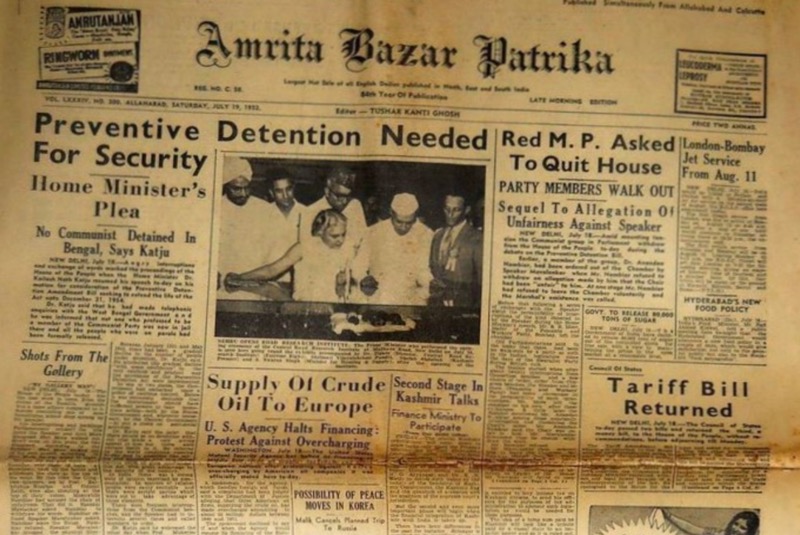When Sir Ashley Eden became the Lieutenant Governor of Bengal, he wanted to rule Bengal with ‘an iron hand.’ However, a certain newspaper, an avid criticiser of the government at the time, proved to be a nemesis. Sir Ashley invited its editor, Shishir Kumar Ghosh, to make a proposal.
‘Let us three, I, you and Kristo Das—govern the province,’ said Ashley. Offering to contribute to the newspaper, he said, ‘When you write an article criticising the Government, you will have to submit the manuscript to me before publication.’
Shishir Kumar refused the proposal and remarked, ‘Your Honour, there ought to be at least one honest journalist in the land.’ Enraged with his response, Ashley reached out to Lord Lytton, Viceroy of India, and convinced him of a gagging act.
On 14 March 1878, the newspaper read the introduction of a bill to control the content of vernacular newspapers and introduce extensive power of the government to curb and repress newspapers from ‘seditious’ writings. The bill was passed in one sitting at the meeting of the Governor General’s Council and was introduced as the infamous Vernacular Press Act of 1878.
The particular newspaper in question was Amrita Bazar Patrika (ABP). This was not the first time it became a target of the British Government in India, and certainly not the last.
Since the day it first rolled out in March 1868, Amrita Bazar Patrika became the voice of people against the Britishers. Three brothers, Hemanta Kumar Ghosh, Shishir Kumar Ghosh, and Moti Lal Ghosh, gave up their jobs to start the weekly newspaper at Amrita Bazar in the district of Jessore. The newspaper was published with a few sections in English and a few in Bengali, consisting of news and editorial remarks.
The name ‘Amrita Bazar Patrika’ was not only indicative of its location but also its role. Amrita meant nectar but also poison—a correct metaphor for the paper as it served as ‘nectar to the right-minded people and poison to the wrong-headed.’
Within a few months of its release, the paper enjoyed a wide readership due to its fearless tone. It spoke up against social issues of caste, child marriage, discrimination based on gender, and abusive government authorities. It made a place in the hearts of people.
In July 1868, just four months later, Patrika had offended an English Sub-divisional officer, Mr. Right, with its criticism. He sued the editor for criminal defamation; however, the court did not find him guilty.
After three and half years of publication, the little village was ravaged by malaria, making it difficult for the editors to operate ABP. The Ghosh brothers moved to Calcutta in October 1871, making it the new publication centre. At the cost of five rupees for an annual subscription, it provided content worth eight foolscap pages.
ABP became increasingly famous for its investigative journalism throughout the country and in Britain. The Bengal Administration report in 1872 published the following:
The Amrita Bazar Patrika is believed by some to be more extensively read than others. The language of its articles is occasionally rough, but it has the merit of discussing social and agrarian subjects both from the tenant’s as well as landlord’s point of view.
Proprietors started receiving requests to send the paper to London as the London papers were quoting from Amrita Bazar to comment on the administration of India. In an article written by Colonel Osborn in 1883, he referred to Patrika to criticise the gagging act and curbing of press freedoms. He acclaimed ABP as ‘the most influential native paper in India.’
When Lord Lytton devised the Vernacular Press Act in 1878, he argued that the vernacular papers were written for ‘half-educated and ill-educated village people.’ The inability of readers to understand English was tagged as a lack of intelligence, which, according to Lytton, made them vulnerable to conspiracies against the government and aroused protest. Hence, the Vernacular Press Act was exclusive to vernacular newspapers.
How did Amrita Bazar Patrika react to it? In just a day after its announcement, the newspaper discarded the Bengali portion of the publication and released itself as an English weekly from 21 March 1878. The change surprised everyone, including the government, and became a mockery of the act that was believed to be passed specifically for ABP.
When Lord Dufferin was the Viceroy of India, Amrita Bazar Patrika published a certain report exposing Sir Lepel Griffin and the affairs of the Bhopal administration. The government in Bhopal was enraged and argued that since the government was not prosecuting the newspaper, it was perceived as either weak or guilty. The Viceroy did not take any actions against ABP, knowing that any proceedings would be protested and bring infamy.
Then again, during the Viceroyalty of Lord Lansdowne, ABP made another sensation. The newspaper reported confidential and highly sensitive information regarding Kashmir on its front page. The report, published by piecing up a torn-up paper found in the garbage, revealed that Viceroy planned to annex Kashmir from Maharaja Pratap Singh. After the news reached the Maharaja, he fiercely protested the authorities in London and successfully maintained his state’s independent status.
This incident led to the passing of an Act to Prevent the Disclosure of Official Documents and Information in 1889. Also known as the Indian Official Secrets Act 1889, it prevented the publication of any report that was not obtained officially. The investigation and disclosure of the Kashmir affairs have been one of the accomplishments of the media during the time.
Amrita Bazar Patrika presented various government secrets and was an important pro-congress voice against the British. The paper strongly supported Bal Gangadhar Tilak in 1897, when he was charged and convicted for a year and a half with sedition for his articles in the newspaper Kesari.
In 1905, when the scheme for Partition of Bengal was disclosed, protestors stormed the streets. Amrita Bazar Patrika vehemently expressed their views against the partition. The Patrika office had served as a centre for many leaders who came to Calcutta to oppose partition and had been said to draw influence from its editors. The ABP was heard as a loud voice against the partition until the very end, when it was annulled.
Amrita Bazar Patrika faced much opposition from the government and was targeted with repressive laws. However, Patrika did not stop publishing and kept getting increasingly popular. Starting as a weekly publication in the small village of Amrita Bazar, the newspaper became a daily publication that supported the Indian Freedom Struggle. It was the seventh largest in circulation in 1945, with active subscriptions of over 30,000. The newspaper is an excellent example of a fearless publication in the history of Journalism in India that has been marked by tireless efforts of the government to curb press freedoms.
-30-
Copyright©Madras Courier, All Rights Reserved. You may share using our article tools. Please don't cut articles from madrascourier.com and redistribute by email, post to the web, mobile phone or social media.Please send in your feed back and comments to [email protected]











